The plaster was certainly prepared from a clay model by McCartan and may have been cast by the artist himself, but perhaps more likely was created as a foundry plaster by the Roman Bronze Works Foundry of New York. The careful handling of a clay model remains visible in the plaster version and has been faithfully reproduced in the metal. The additive and subtractive techniques used to form the sculptural group are especially apparent in the stylized ringlets of the figure’s hair and in the unique panels that make up the decorative relief border on the integral plinth base (fig. 1).
Examination and Treatment of the Large Bronze, "Isoult", 1926, by Edward McCartan
Katy May, Conservator, Object Conservation Department

Edwaerd McCartan, Isoult, 1926, front and back views
Fabrication
Typical for the period and for large-scale bronze works, Isoult is a hollow, lost-wax bronze cast indirectly from the plaster version that is now in the collection of the Academy of Arts and Letters, New York.
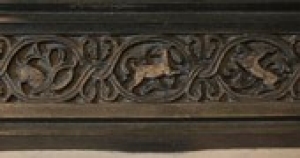
Fig. 1 Decorative relief border on the integral plinth base

Fig. 2 Schematic showing the six separately cast sections of the bronze
X-radiography indicates that the sculpture was cast in six separate sections that were subsequently joined together: the legs, torso, and head of the figure; each arm; the fawn’s head; the fawn’s body; and the base (fig. 2).
Mechanical “Roman” joins are present at both upper arms (figs. 3 and 4), at the join between the fawn’s head and body, and where the figure and fawn join the base (fig. 5). A mechanical join between the figure and the fawn along the figure’s lower right leg is also likely present but was not revealed through x-radiography
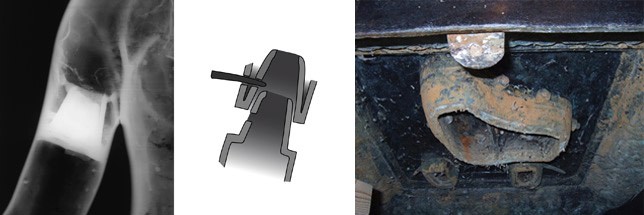
From left to right:
Fig. 3 X-radiograph of proper right arm showing the mechanical "Roman" join
Fig. 4 Illustration of a typical mechanical "Roman" join
Fig. 5 Photograph of one of Isoult's joins
The core appears to have been thoroughly removed from each section before assembly through openings at the top of the figure’s head, on the bottoms of the feet, and at areas to be joined: the upper arms, the proper right calf, and the fawn’s neck. The hole at the top of the figure’s head, which in the casting process would have allowed for the placement and removal of a core armature as well as core vents, was later filled with metal and is barely detectable.
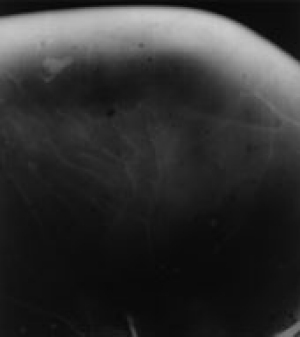
Fig. 6 X-radiograph of lower left leg showing evidence of the casting process
Core material appears to be largely intact in the figure’s lower left leg, where access to the interior of the sculpture would be restricted. Numerous drips present on the interior of the cast are visible in the x-radiographs, apparent remnants from slush casting of the wax model that are now preserved in the metal (fig. 6).
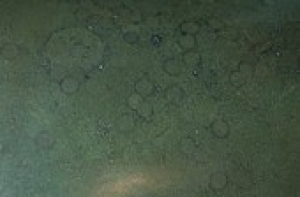
Fig. 7 Numerous threaded repairs visible on the fawn's back
There are numerous threaded repairs in a variety of diameters, especially obvious across the fawn’s back (fig. 7), as well as an apparent cast-in repair on the figure’s left thigh. The fawn’s body was undoubtedly cast upright; the large number of threaded repairs across its back is indicative of increased porosity in the upper sections of the casting, the result of gases rising to the top of the solidifying metal. The figure may have been cast upright as well, a theory supported by the relative lack of threaded repairs on the feet and lower legs, and the porosity visible on the top of the head and the upper shoulders, which was not repaired as it would not be visible.
The surface is otherwise highly finished and must have been extensively cold-worked to render the joins invisible and to eliminate casting imperfections. Files have been used liberally over areas intended to be smooth. On the face and higher points of relief, file marks have been removed either through subsequent finishing with progressively finer abrasives or through weathering of the surface. There is no evidence of the use of chisels, punches, or gravers to more sharply delineate forms or to eliminate small casting imperfections in recesses of the figure’s hair, the fawn’s ears, mane, and tail, or the base.
Study of the sculpture with a Keymaster Tracer III-V hand-held x-ray fluorescence (XRF) analyzer characterized the elemental composition of the surface.[1] The alloy of the sculpture was determined to be a medium-tin bronze composed of approximately 87 percent copper, 9 percent tin, 1 percent zinc, 2 percent lead, and less than 1 percent iron.[2] The impurities—nickel, arsenic, silver, and antimony—were not detected,[3] which is consistent with electrolytic refinement, a standard practice for early 20th-century bronze casting.
Condition
While the sculpture is structurally stable, the patina is mottled and disfigured, apparently the result of prolonged outdoor exposure. The surface is primarily a dark matte green with numerous lighter green drip marks. Moderate surface pitting is evident, especially over the hair and neck and in light green areas, such as the upper back, upper surfaces of arms, and the fawn’s back. A dark brownish-red surface, most likely a cuprite [4] layer, is visible in areas of flaking patina and in the center of some of the drip marks. Numerous superficial scratches are evident in the patina, as well as scattered transfers, most of which appear whitish in color. A textile pattern, perhaps transferred from packing materials, is visible across the figure’s left thigh and right hip.
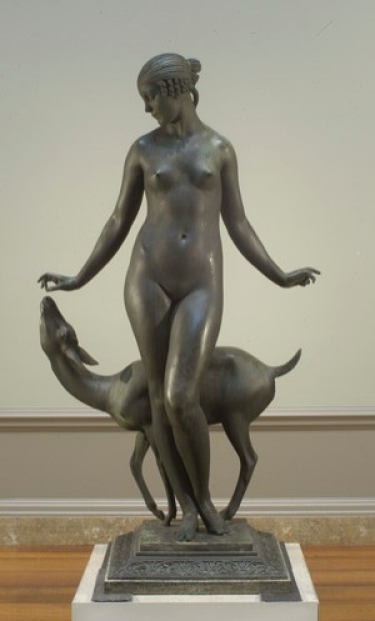
Fig. 8 Pre-treatment photograph of Isoult
The base is moderately abraded along the edges. Before conservation (fig. 8), a thick layer of white crystalline deposits, as well as impacted dirt, was present covering the lowest register of the base and within the recesses of the decorative relief border. The original owners and commissioners of Isoult, Junius and Louise Morgan, sited the sculpture very near, or even within, a reflecting pool in the garden on their estate. The crystalline deposits on the base indicate that the sculpture was subjected to the rising and falling levels of water rich in dissolved minerals. As the water evaporated, the dissolved minerals deposited onto the sculpture’s surface. An apparent water line crossing the figure’s right ankle and left foot may represent the water’s highest level and is further evidence that the sculpture was partially submerged for an extended period of time. National Gallery of Art conservation scientists identified the thick crystalline deposits as calcium carbonate (with a minor amount of quartz) using the analytical technique of x-ray diffraction.[5]
In addition to a technical examination, a full conservation treatment was performed on the sculpture, in consultation with Gallery curators. Accumulated dirt and grime were removed from the surface, calcium carbonate deposits were reduced from the base, and the mottled and streaked patina was unified through the application of a protective wax coating and localized inpainting (figs. 9–11).
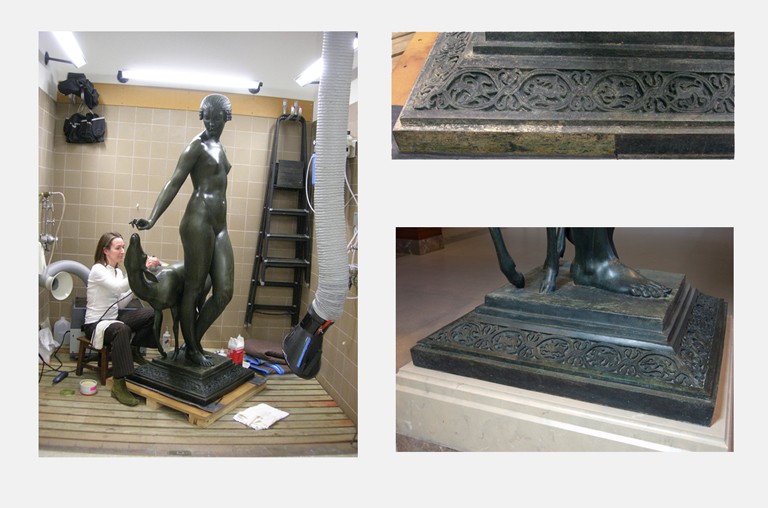
Clockwise from the left:
Fig. 9 Isoult during conservation treatment
Fig. 10 Detail of the integrated base before treatment, showing calcium carbonate deposits
Fig. 11 Detail of the integrated base after treatment
[1] XRF is a noninvasive technique that assesses the metallic composition of the surface of a bronze to a depth of 100 microns, and only represents the bulk alloy to the extent that the surface is representative. The Keymaster Tracer III-V hand-held x-ray fluorescence analyzer uses a tube with a rhodium target, operated at 40 kilovolts and 1.8 microamps, with a sandwiched filter of 25.4 micrometer titanium and 304.8 micrometer aluminum, in non-vacuum mode, with data collected for 60 seconds of live time for each spectrum. The area examined in each spectrum is an oval approximately 6 mm in diameter. The instrument was used nearly in direct contact with the bronze surface; a thin layer of inert foam (under 1 mm while compressed slightly on contact) protected the surface from the head of the instrument.
[2] Ten locations on the patinated surface were selected for analysis; five of these analyses produced useable data that was averaged to determine the overall metallic composition. Prolonged outdoor exposure resulted in a moderately thick corrosion layer on upper horizontal surfaces and over the entire base. Because of corrosion and associated surface enrichment, as well as contamination from calcium carbonate deposits, five analyses could not be used to determine the overall metallic composition, as elemental totals were significantly lower than 100 percent.
[3] The estimated minimum levels of detection for the trace elements iron, nickel, arsenic, silver, and antimony are approximately 0.1 percent. In a visual examination of the spectra for each of the analyses, representative peaks for nickel, arsenic, silver, and antimony were not distinguishable from the background.
[4] Cuprite, Cu2O, a copper corrosion product resulting from the reaction of copper with dissolved O2 or water molecules, is frequently observed as the initial corrosion layer on corroded bronze surfaces.
[5] Analyses performed by the scientific research department, National Gallery of Art, August 24, 2005.
Conservation Division
National Gallery of Art
2000B South Club Drive
Landover, MD 20785
[email protected]